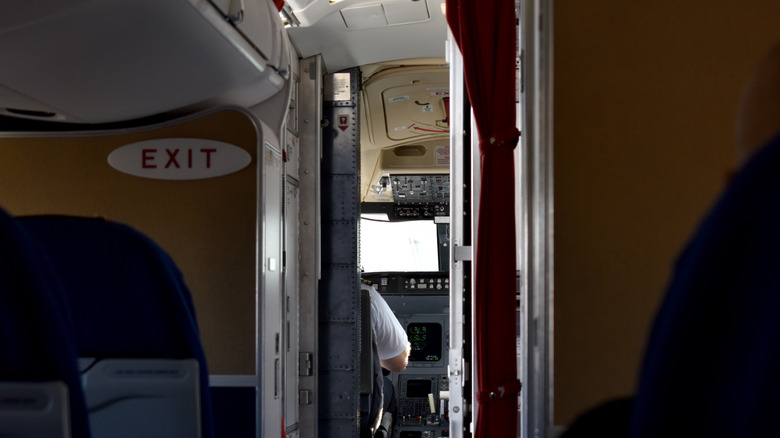Pilot Makes Emergency Landing After Hearing 'Banging' On Cockpit Door
An American Airlines flight operated by SkyWest Airlines made an emergency landing at Omaha's Eppley Airfield just 18 minutes after it had taken off from the same airfield, due to banging on the cockpit door. The problem wasn't just down to the fact that the flight crew could hear banging on the cockpit door. It was more what they couldn't hear — the cabin crew over the intercom system.
American Airlines reports that the intercom system had been left on accidentally, meaning the pilots could only hear static. It also left the cabin crew unable to communicate with the pilots. Because of this, the flight attendants had resorted to banging on the cabin door to attract the pilots' attention. From the flight crew's perspective, the communication failure meant they had no way to audibly identify who was knocking at the door and took the decision to return to the airfield.
The aircraft, an Embraer ERJ 175 regional jet, had taken off at 6.41 pm en route to Los Angeles. It eventually took off again about four hours and 20 minutes later. For the passengers on the plane, the incident was certainly dramatic. Speaking to CNN, passenger Henry Gruver said, "All of a sudden, we started banking around the city of Omaha. And, you know, you're tilting the wings and everything. My wife noticed that the stewardess was kind of banging on the cockpit door, like, OK, what's going on?" Mr Gruver and his family subsequently missed their connecting flight to Japan because of the incident.
Why a simple failure triggered an emergency protocol
In a statement, SkyWest said that the plane returned to Omaha after the flight crew exercised an "abundance of caution." There are solid motives as to why the flight crew exercised such an approach, some of which can be traced directly back to the tragedies of 9/11. One of the hard lessons learned in the wake of these events was the need for tightened cockpit security. This not only covered the compulsory installation of hardened flight deck doors, but also a series of protocols that determine when cockpit doors can be opened, with airlines operating approved procedures.
More specifically, one regulation that can be used to explain the flight crew's caution is FAA regulation §121.584. This spells out in what circumstances a cockpit door can be opened. From the moment the airplane moves until it has safely landed, this regulation only allows the door to be opened if audio and visual devices are first used to establish that the cabin is secure. While the breakdown of audio communication can partially explain the pilots' decision, it's unclear why they didn't pick up on any visual clues that could have alerted them to the actual situation. Even in the absence of security cameras on planes, a peephole on the cockpit door is listed as standard equipment in FAA documentation for this model.
Ultimately, if the pilots were under any doubt about the security of the flight, then the safest move is to get the flight back on the ground.

